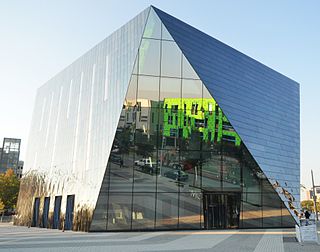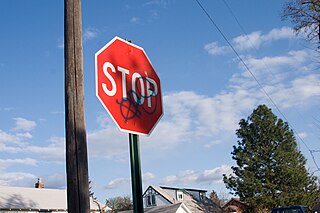
Graffiti is art that is written, painted or drawn on a wall or other surface, usually without permission and within public view. Graffiti ranges from simple written "monikers" to elaborate wall paintings, and has existed since ancient times, with examples dating back to ancient Egypt, ancient Greece, and the Roman Empire.

Sticker art is a form of street art in which an image or message is publicly displayed using stickers. These stickers may promote a political agenda, comment on a policy or issue, or comprise a subcategory of graffiti.

Wildstyle is a complicated and intricate form of graffiti. They are the most complex type of pieces. Due to its complexity, wildstyle can be difficult to read for those unfamiliar with the form and process. It is considered the most difficult graffiti style to master.

Street art is visual art created in public locations for public visibility. It has been associated with the terms "independent art", "post-graffiti", "neo-graffiti" and guerrilla art.

Stencil graffiti is a form of graffiti that makes use of stencils made out of paper, cardboard, or other media to create an image or text that is easily reproducible. The desired design is cut out of the selected medium and then the image is transferred to a surface through the use of spray paint or roll-on paint.

A number of words and phrases that have come to describe different styles and aspects of graffiti and its subculture. Like other jargon and colloquialisms, some of these terms may vary regionally, taking on different meanings across different cities and countries. The following terminology originates primarily in the United States.

OSGEMEOS are identical twin street artists Otavio Pandolfo and Gustavo Pandolfo. They started painting graffiti in 1987 and their work appears on streets and in galleries across the world.

Michael Christopher Tracy, known as Tracy 168, was an American graffiti artist. He pioneered the art form known as wildstyle. Tracy 168 came to be known as one of the most influential graffiti and street artists of all time, as variations of wildstyle writing spread around the world. He is acknowledged to have been a seminal figure in the development of street art. Books about 1970s graffiti feature his car-long paintings with their characteristic kinetic script embellished with flames, arrows as well as cartoon characters and the "Tracy face," a grinning shaggy-haired visage in wrap-around shades.

The Museum of Contemporary Art Cleveland is a contemporary art museum in Cleveland, Ohio, United States. It is the only contemporary art venue of its kind in Metropolitan Cleveland. The organisation was founded by Marjorie Talalay, Agnes Gund, and Nina Castelli Sundell in 1968 and has undergone several name and venue changes in the years following its 1968 founding. Originally known as The New Gallery, the museum was rebranded as the Cleveland Centre for Contemporary Art in 1984. The gallery has operated under its current branding as the Museum of Contemporary Art Cleveland (moCa) since 2002.

Donald Joseph White, "DONDI" was an American graffiti artist.
Melbourne, the capital of Victoria and the second largest city in Australia, has gained international acclaim for its diverse range of street art and associated subcultures. Throughout the 1970s and 1980s, much of the city's disaffected youth were influenced by the graffiti of New York City, which subsequently became popular in Melbourne's inner suburbs, and along suburban railway and tram lines.

Stephen J. Powers is an American contemporary artist and muralist. He is also known by the name ESPO, and Steve Powers. He lives in New York City.

Hosier Lane is a laneway in the central business district (CBD) of Melbourne, Victoria, Australia. Located on the CBD's southern edge, it extends between Flinders Street and Flinders Lane, and opens opposite the Atrium at Federation Square. Since the late 1990s, Hosier Lane has become a popular tourist attraction due to its street art. Despite popular belief, Hosier Lane is not a legal wall, and graffiti in the area is illegal.

Graffiti are writing or drawings scribbled, scratched, or sprayed illicitly on a wall or other surface in a public place. Graffiti ranges from simple written words to elaborate wall paintings. Graffiti, consisting of the defacement of public spaces and buildings, remains a nuisance issue for cities.
Fred Fowler is an Australian-born visual artist, specialising in painting, drawing, bronze sculpture and printmaking.

Graffiti in New York City has had a substantial local, national, and international influence.
Facter, or Fletcher Anderson, is a Melbourne based, Australian multi-disciplinary artist, best known for his colorful creatures rendered in a illustrative style.

Tags are one of the primary forms of graffiti, along with throw ups and pieces. The act of writing a tag is known as tagging. Tags are often thought of as the simplest form of graffiti art, prioritising legibility and flow and are the form that most artists start with. Tags, perhaps due to their simplicity, are more likely to be considered vandalism than other more elaborate graffiti styles.

Throw ups, or throwies, are a form of graffiti that fall between tags and pieces in complexity. The name comes from the way they are designed to be "thrown" onto a surface as quickly as possible. They are almost always done with aerosol paint.

Legal walls or open walls, are public spaces where graffiti is allowed by any member of the public.


















